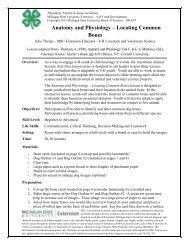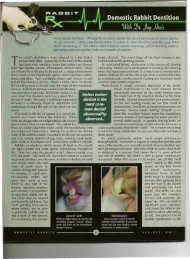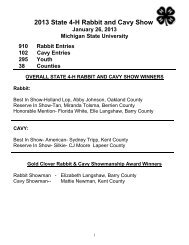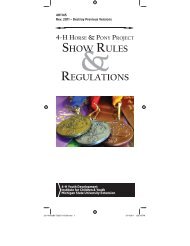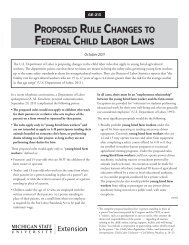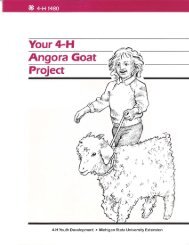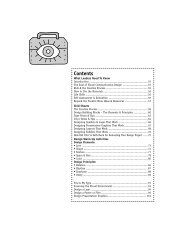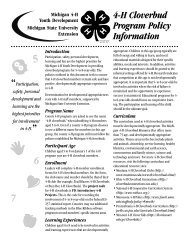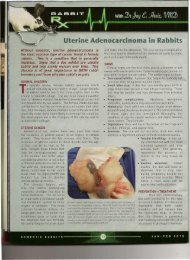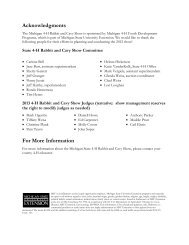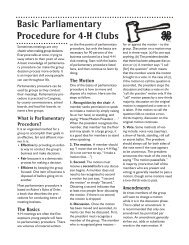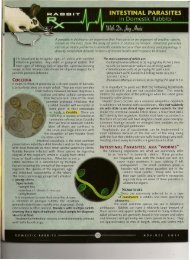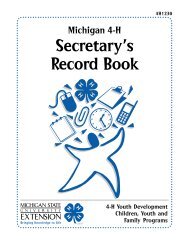Rabbit RX The Health Certificate with Dr. Jay Hreiz - Michigan State ...
Rabbit RX The Health Certificate with Dr. Jay Hreiz - Michigan State ...
Rabbit RX The Health Certificate with Dr. Jay Hreiz - Michigan State ...
Create successful ePaper yourself
Turn your PDF publications into a flip-book with our unique Google optimized e-Paper software.
<strong>The</strong> world is shrinking due to technology. Airplanes, the worldwide<br />
web, cell phones, e-mail, and countless other pieces of technology are<br />
all reasons why the exchange of ideas is so much more pronounced in<br />
the 21Stcentury. Our hobby of raising rabbits and cavies is now part of<br />
this concept as well. Shipping rabbits domestically and internationally<br />
is steadily gaining popularity <strong>with</strong> ARBA members on almost every<br />
continent. A crucial component to the shipping process is the generation<br />
of a health certificate for the rabbit or cavy that will be traveling to all<br />
corners of the world. This article is intended to introduce breeders to<br />
the concept of a health certificate and the information necessary to<br />
successfully complete one. .<br />
CREDENTIALS: DOCTOR OF VETERINARY MEDICINE<br />
Simply put, a health certificate can only be written by a<br />
veterinarian. Specifically, this veterinarian must be USDA<br />
licensed in the state he or she resides in. <strong>The</strong> veterinary<br />
profession is in the process of initiating a national<br />
accreditation program that will eventually integrate into all<br />
health certificates as well. <strong>Health</strong> certificates have an area<br />
that asks for the license information for the veterinarianexamining<br />
the animals you intend to ship.<br />
,<br />
FORMS: ELECTRONIC OR PAPER<br />
<strong>The</strong> USDA Form 7001 is entitled "United <strong>State</strong>s Interstate<br />
and International <strong>Certificate</strong><br />
of <strong>Health</strong> Examination<br />
for Small Animals." This<br />
is available in electronic<br />
format (.pdf) which can<br />
be filled out and printed<br />
as well as a paper version<br />
obtainable from the <strong>State</strong><br />
Department of Agriculture<br />
that has multiple carbon<br />
copies adhered to it. Either<br />
form is generally acceptable<br />
and I have personally found<br />
the new electronic version<br />
to be markedly easier to fill<br />
out. Make sure the veterinarian who is filling out the form<br />
saves a copy ofthe electronic version in his personal records<br />
in case they need to be reproduced in the future!<br />
INDIVIDUAL SECTIONS<br />
This section will require you to identify the species<br />
(rabbit or cavy), total number of animals, and number of<br />
pages (generally just one). <strong>The</strong> consigner is considered the<br />
owner of the<br />
animal. This is<br />
the individual<br />
who will be<br />
shipping the<br />
animal. <strong>The</strong><br />
consignee is the individual who the animals are being<br />
shipped to. This could also be called the future owner. You<br />
must know the name, address, and telephone number of the<br />
consigner (you) and consignee (new owner).<br />
ANIMAL INFORMATION CD<br />
You many enter up to six animals at a time on the health<br />
certificate when filling out the form. For additional animals,<br />
please use a new sheet for each set of six. Having an electronic<br />
copy makes this process much easier than an entire new<br />
carbon copy set.<br />
NAME, AND/OR TATTOO NUMBER<br />
OR OTHER IDENTIF ICATION:<br />
This is exactly what it implies. Simply list the animal's name<br />
(rabbitry name in front of the animals name is acceptable)<br />
along <strong>with</strong> the tattoo number from the left ear.<br />
BREED<br />
Common or scientific name: Again this is a simple listing of<br />
the rabbit or cavy breed.<br />
AGE, SEX, COLOR OR DISTINCTIVE<br />
MARKS OR MICROCHIP:<br />
<strong>The</strong> age and sex are obtained from the pedigree and general<br />
knowledge. Color can simply be listed from the pedigree as<br />
well or ARBA registration for accuracy. <strong>Rabbit</strong>s and cavies can<br />
be microchipped but this is uncommon in the ARBA.
RABIES VACCI ATION, OTHER<br />
VACCI ATIONS, TREATMENT,<br />
CD<br />
AND!<br />
OR ES RESULTS:<br />
I ge eral, rabbits and cavies are NOT<br />
a • a ed against rabies. In addition,<br />
eterinarians do not recommend<br />
nless the rabbit is in a high-risk<br />
e ironment. Local and/or state<br />
IOnNumblril<br />
ordinances may occasionally require<br />
NAVE.ANDo'ORTATTOONU~<br />
OfI:OnER!DEHrFlCA.1KlH<br />
a rabies vaccine to be administered,<br />
which must be investigated prior to<br />
' '\<br />
shipment. Some countries, like Japan,<br />
~<br />
not only require a rabies vaccination<br />
.,<br />
but a subsequent titer (proof that the<br />
rabbit has the appropriate number<br />
of antibodies mounted against<br />
rabies following vaccination) when<br />
shipping dogs and/or cats. <strong>The</strong>se<br />
VERY important caveats need to be<br />
investigated months before shipment<br />
to ensure a safe and seamless<br />
transport. We do not routinely<br />
APHIS Form 7001<br />
vaccinate rabbits or cavies against any<br />
other pathogens. Other treatments<br />
and test results include any worming<br />
treatments done (ivermectin, fenbendazole, etc.).<br />
VETERINARY CERTIF ICATION CD<br />
In this section, the veterinarian examining your animals<br />
will verify that your rabbit or cavy is free of infectious<br />
disease, microchipped if indicated earlier, and free of<br />
rabies if the destination requires vaccination and/or a titer.<br />
<strong>The</strong> veterinarian then records his or her name, address,<br />
telephone number, license number and state, whether or<br />
not he or she is nationa lIy accredited, and if so their national<br />
accreditation number. Please note that the USDA state and<br />
national accreditation numbers are different. He or she will<br />
sign and date the document, which will render it valid for<br />
interstate and international shipment.<br />
INTERNATIONAL SHIPMENT 0<br />
Many foreign countries require validation of the health<br />
certificate by the state USDA veterinarian in order for it to<br />
be complete prior to shipment. This is an additional step<br />
hat is done once your local veterinarian has completed the<br />
form. A fee imposed by the state USDA is necessary in order<br />
-0 process it at the state USDA office. This official certificate<br />
"II then be mailed to your home address.<br />
5. NAME, ADDRESS. AND TELEPHONE NUMBER OF OWNER (CONSIGNOR) .". ~ '.LNAMEt ADDRESS, AND TEl£PHOHE HUMBER OF RECIPIENT AT OeSTIHATIott (CONSlGN£E1<br />
7. ANIMAL 10000ACAnON<br />
AGE<br />
SEX<br />
~~. &.'<br />
','~~<br />
I--<br />
~Jf@JJcmrB~(b><br />
e. P£RTlNENTVACCINATlON, TREATNEHf AHOTEST1HGHISTOftY<br />
OllER VACCIKATKlHS,<br />
TREATIoENT. Ao"OlORTESTS ANORESULTS<br />
., 1 Jr---t----+--+-t---l---+-I/ 2 ,)---l--+--------<br />
") I--t----'f--+-+---+--+---\'-../J---+-+--------<br />
9. REMAAKS ORADDmONAL CERnFICATIOH STATEMEHTS (WHEN REQUIRED)<br />
COST<br />
<strong>The</strong> cost of a health certificate ranges widely. Many<br />
veterinary clinics will do them for free while some may<br />
(NOV2010) This certiflCalQ Is valid lor 30 days aftorlssuance<br />
~HARYCERTlflCATlO~ l~tllMlJ\ea'l!malsOIOtol...,~q..._--'..aIr;tI--- ...<br />
tor~~~:..:.":·'·)G~~_on~--..)iI'lfII'I'IcoIblto.~--<br />
o<br />
NAME, AOORESS, AND TELEPHONE NtJM&ER OF ISSUING VETERINARlAH<br />
•••• noI~<br />
UCEHSE HUMBER AND STATE<br />
ACc,edlWd YM No<br />
l1Jffmliwm;NUMB~""<br />
charge as much as $50-$100 per animal shipped. Please<br />
keep this in mind when budgeting for the entire shipment<br />
process! Fees imposed by the state USDA for international<br />
travel are separate from your veterinarian and must be<br />
factored in as well.<br />
IN A NUTSHELL<br />
<strong>The</strong> most important piece of advice from a veterinarian<br />
to a breeder hoping to ship rabbits or cavies internationally<br />
is to thoroughly investigate the process of shipping before<br />
going through <strong>with</strong> it. Most airlines would like the health<br />
certificate generated <strong>with</strong>in 10 days of travel. Despite<br />
this, I still recommend making sure all other aspects of the<br />
transport be taken care of 3-6 months prior to shipment.<br />
<strong>Jay</strong> E, <strong>Hreiz</strong>, VMD - Chairman,<br />
ARBA <strong>Rabbit</strong> & Cavy <strong>Health</strong><br />
Committee. <strong>Dr</strong>. <strong>Hreiz</strong> is a graduate<br />
oj Penn's Veterinary<br />
currently<br />
School and<br />
works as an associate<br />
veterinarian at a small animal!<br />
exotics practice in the Charlotte,<br />
NC area,<br />
Judge#7B9<br />
He is also an AR8A



